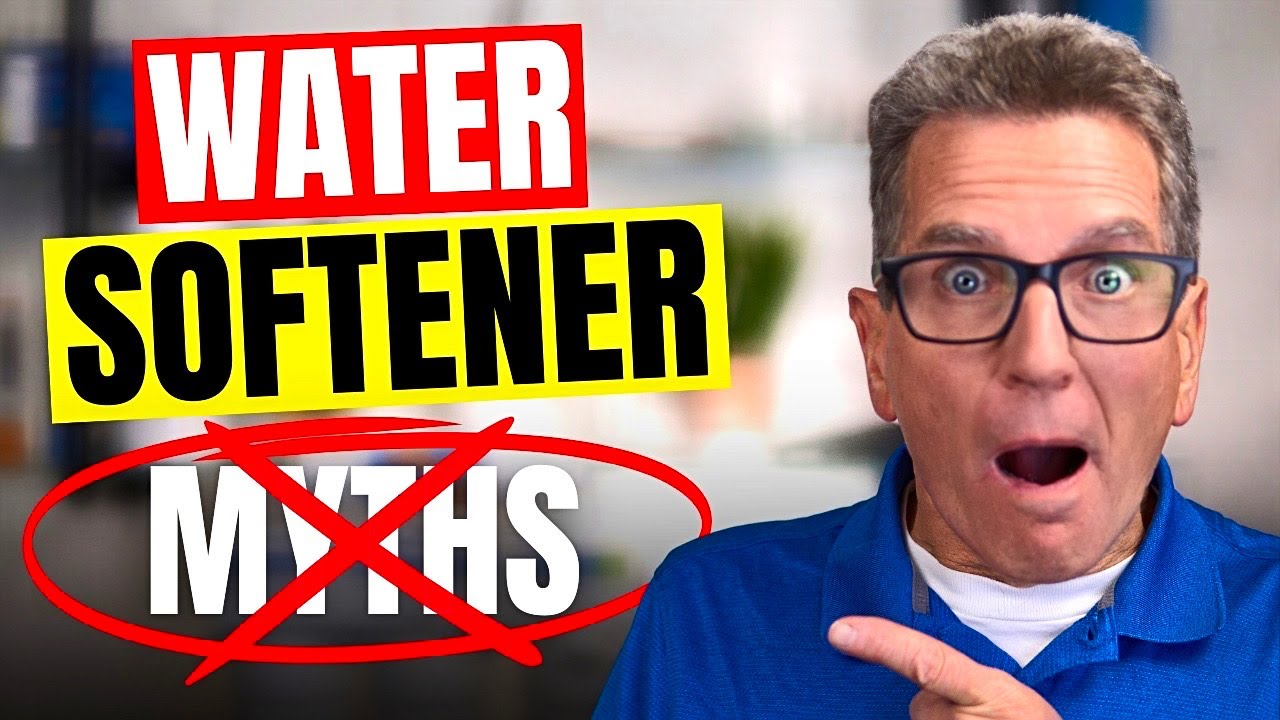
Are you tired of dealing with common misconceptions about water softeners? Well, you've come to the right place! I'm Gary the Water Guy, and I'm here to demystify water softeners and provide you with the real facts.
In this article, I'll debunk 14 water softener myths for you and shed light on what actually happens when you use a water softener in your home. Follow along as you discover how water softeners can greatly improve the performance and lifespan of your water-using appliances and also make your water gentler on your family's skin, hair, and clothing. Plus, learn how they contribute to a cleaner and more manageable home environment!
DEBUNKING WATER SOFTENER MYTHS
With my simplified approach to water filtration, I'm here to help you conquer the challenges of dealing with less-than-perfect water quality and understanding what your options are for soft water in your home. Be sure you check out all 14 water softener myths here because many of them will surprize you, especially that last one!
1. If you’re on city water, you don’t need a water softener.
The water from most cities comes from wells. So, If it comes from the ground, then it has absorbed minerals from the rocks it comes into contact with and it’s now hard. How hard? Call your water provider and ask them — you may be shocked!
2. Softened water contains a lot of sodium.
In reality, softened water contains such a small additional amount of salt that it will have no impact on your diet at all.
For example, if water has a hardness of 10 grains per gallon, it will contain an extra 35mg of sodium per 8oz glass after being softened. To put this in perspective, a tablespoon of ketchup has 204 mg of sodium and a slice of whole-wheat bread has 211 mg of sodium.
Absolutely don’t want to soften your drinking water? No problem. You could only soften your hot water line and bypass the cold line or just bypass the kitchen cold water line. This leaves the cold water untouched for drinking and the hot water soft for bathing and appliances like washer and dishwasher.
If you’re still concerned about the salt added by a water softener, our HUM water softeners can use potassium chloride instead of sodium chloride.
>> Find Out the Best Water Softener Salt to Use
But a far better alternative is to get a Reverse Osmosis drinking water system for just one drinking water tap at your kitchen sink. This would not only eliminate the salt added by your water softener it would also eliminate the salt that’s in your water going into the water softener.
3. Water softeners waste a lot of water.
This may have been true a couple of decades ago but water softeners these days are highly efficient when it comes to water usage.
The Clack WS1 valve that we use exclusively on our HUM Water Softeners automates the regeneration process based on your water usage. This means the system is not regenerating needlessly every 3, 4, 6 or 10 days and uses as little water as possible because it measures how much water you actually use and only regenerates when it needs to.
In fact, washing and bathing with hard water will use more water because soap does not work well with hard water. So hard water doesn’t allow soap to lather and you need a lot more water to wash those detergents out of your clothes.
You’ll see virtually no impact on your water bill after installing a water softener.
4. Water softeners will drastically increase your electrical bill.
The rest of the time water is just flowing through the system with virtually no electricity used at all. A modern electronic valve uses only $2.00 worth of hydro per year.
5. Softened water leaves a slick film on your skin after bathing.
Nope, it’s the opposite. Hard water leaves soap on your skin and leaves your skin dry and brittle. So, after installing a water softener, many people are not used to the feeling of that film being washed away.
The slickness on your skin when you bathe in soft water is actually your body’s natural essential oils. That’s what clean feels like!.
6. Adding salt makes water soft.
Check out this quick overview of how softeners work and you’ll soon realize how false that myth is!
- Hard water (water containing calcium and magnesium) enters the water softener.
- The resin beads within the softener are charged with sodium on the resin beads.
- When the calcium and magnesium pass through the resin beads, the calcium and magnesium changes places with the sodium.
- This causes the calcium and magnesium molecules to cling to the beads and the product water includes amounts of sodium instead.
- After an adequate amount of water has gone through the system, a backwashing cycle takes place.
- During the backwash cycle, sodium chloride (table salt) passes through the resin beads. It’s used to wash away the calcium, magnesium and iron, if there is any from the resin beads. The salt gets washed away with the calcium and the magnesium.
- The sodium is left on the resin beads and the process starts all over again.
So, as you can see, virtually no salt ends up being added to the water your family actually uses. For a more in-depth explanation, check out the video I’ve linked below.
>> How Does a Water Softener Work
7. Water softeners remove harmful bacteria and viruses.
Water softeners are great for making your water soft but they will not remove bacteria, viruses or even tannins from your water.
At Water eStore, we recommend adding an Ultraviolet (UV) filter if you want to make sure that your well or lake water is bacteria-free for your family.
8. Water softeners remove essential minerals from your water that the body needs.
Through ion exchange, water softeners remove calcium and magnesium from your water making it soft. Some folks believe these are essential minerals needed in drinking water.
However, while calcium and magnesium are abundant in hard tap water, these minerals are not beneficial in your water because these dissolved solids are still in their inorganic form. In other words, our body cannot digest these minerals the same way it does with the minerals found in our food. Get your minerals from your food!
9. Salt-Free Water Softeners are a good option.
These systems do not remove calcium and magnesium and therefore are often called a “water softener alternative”. There is no such thing as a salt-free softener. Softeners by definition remove calcium and magnesium, the so-called “salt-free” softeners only suspend calcium and magnesium temporarily in your water, but it’s still hard. They don’t work!
10. Water Softeners are a waste of energy.
Water softeners provide benefits for any appliance or surface that comes in contact with the water in your home.
The calcium and magnesium molecules in hard water cause scaling. This is true in pipes, faucets, and water-using appliances, such as dishwashers, clothes machines, and coffee makers. This scaling will often contribute to a loss in efficiency and breakdowns in appliances.
Such as layering on top of heating coils in coffee makers, or clogging holes and water passages in machines like dishwashers, and can often be attributed to other breakdowns.
A study conducted by the WQRF discovered that water heater units maintained their factory efficiency rating for as long as 15 years when using soft water. While the unit’s efficiency would be cut in half when using hard water.
Scale buildup shortened the lifespan of the heating elements inside electric water heaters, and some tankless water heaters using hard water failed after just 1.6 years. So water softeners actually save energy.
11. Softened water is healthier to drink.
Many people believe that a water softener and a water filter or purifier are one and the same. But they’re not.
A water softener softens water but it won’t filter out dirt, tannins or bacteria. If you have any of those you’ll need a different type of water filtration.
So, while some people may prefer the taste of soft water, it is not more or less healthy for you to drink than hard water.
12. The type of salt you use in your water softener brine tank doesn’t matter.
Some people believe that all water softener salt is the same when it comes to softening. However, using purer salt with fewer contaminants will keep your water softener running more efficiently and give it a longer lifespan. It will also require less cleaning. I suggest Windsor Clean and Protect water softener pellets or a similar salt pellet.
>> Find Out the Best and Worst Water Softener Salt
13. Water softeners require a lot of maintenance.
While it’s true that water softeners require some maintenance, it’s pretty much non-existent. Water softeners only require the addition of salt to the brine tank, and that’s simple. The injector might need cleaning after 7 or 10 years if you have iron in your water, but that’s it.
14. Water Softener Systems are expensive to run.
There’s no denying the fact that water softeners are an investment for your family. You would invest between $1,000 and $2,000 or more in a water softener for your family but check out this video to learn how that investment will actually pay for itself in just a few years. And after that time, they’ll actually save you money for your family.
BUT how much? Click below to find out!
There you have it — we've shared the inside scoop on everything water softeners and answered all your questions regarding the top myths related to them! From their water and energy consumption to the many benefits water softeners offer for your household appliances and even your skin!











